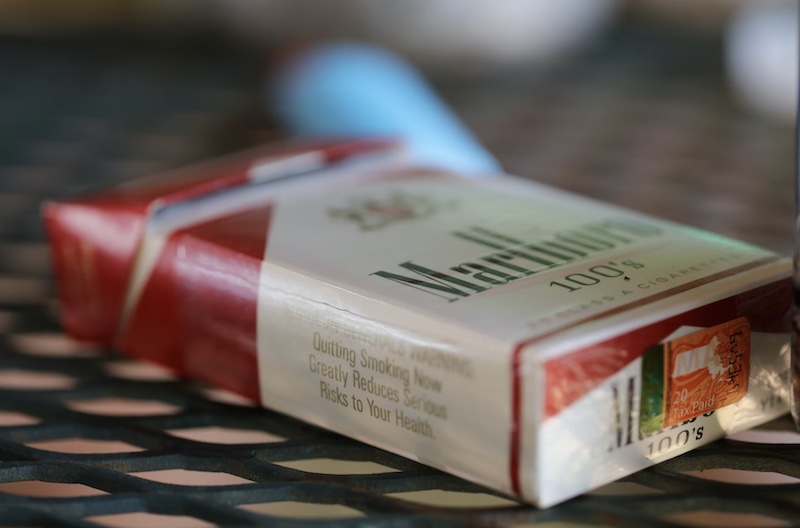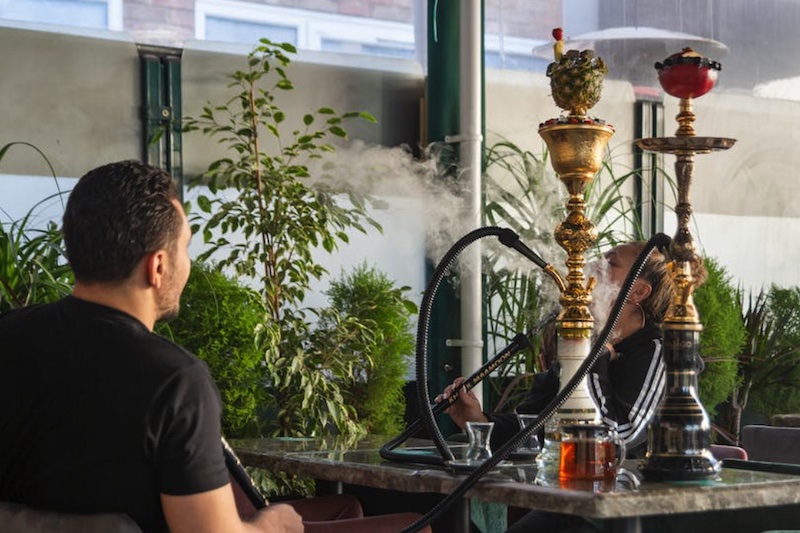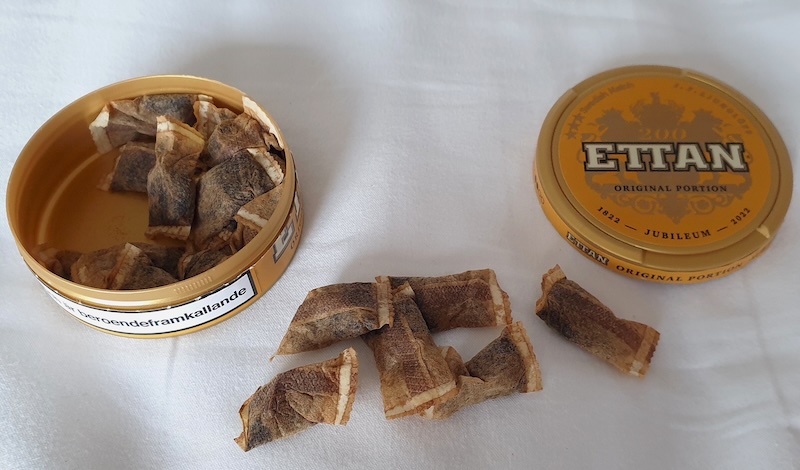Smoking & Tobacco Product Detection
Table of contents
Overview
The Smoking & Tobacco Product detection model helps you determine if an image or video contains tobacco products and smoking-related situations such as:
- people visibly smoking (such as holding a cigarette or puffing smoke)
- cigarettes, cigarette butts, cigarette packs and similar paper-based smoking products
- cigars
- pipes
- hookahs, shishas
- vapes and vaping products
- loose or chewing tobacco
This model focuses on products that are legal in most jurisdictions.
To detect marijuana-related smoking such as joints, cannabis, marijuana leaves, processed marijuana or to detect devices usually related to the consumption of illegal drugs (such as bongs or glass pipes) use the Drug Detection model.
Regular tobacco
The regular_tobacco class is used to flag tobacco products and smoking scenes that do not include any references to marijuana/cannabis or other drugs.
The following situations will be flagged:

Cigarettes & cigarette butts
Typical commercial cigarettes or cigarette butts. This does *not* include joints that are visibly associated with marijuana.
regular_tobacco

People smoking or puffing smoke
Displays of people visibly smoking, such as holding a cigarette, cigar or pipe, puffing smoke, or having their face surrounded by smoke. This does *not* include cases with references to marijuana.
regular_tobacco

Cigarette packs
Typical commercial cigarette packs, as sold in stores.
regular_tobacco

Cigars
Cigars in hand or in cigar boxes.
regular_tobacco

Smoking Pipes
Tobacco pipes, either in hand or not. This does not include glasspipes.
regular_tobacco

Hookahs, shishas or waterpipes
Instruments used for smoking, especially in some European or Middle-Eastern countries. This does not include bongs.
regular_tobacco

Chewing or loose tobacco
Tobacco products that are not smoked: chewing tobacco, snuff, dip and loose tobacco.
regular_tobacco

Vapes and electronic cigarettes
Vapes, vape juice, vape cartridges, unless they have marijuana symbols.
regular_tobacco
Ambiguous tobacco
In some cases, it is not possible to determine if a hand-rolled cigarette contains only regular tobacco or if it also contains marijuana/cannabis/weed. In such cases, the API will return the ambiguous_tobacco tag:

Ambiguous cigarette or joint
Hand-rolled cigarette/joint/blunt/cigarillo where it is unclear whether the content is tobacco or marijuana due to shape, zoom or visibility.
ambiguous_tobacco
If there are additional signs that the content is marijuana-related (such as the color or shape of the joint, the image context, marijuana symbols or references, marijuana-related paraphernalia etc), then this will not be flagged here. To detect such instances, use the Drug Detection model.
Use the model (images)
If you haven't already, create an account to get your own API keys.
Detect Tobacco content
Let's say you want to moderate the following image:

You can either share a URL to the image, or upload the image file.
Option 1: Send image URL
Here's how to proceed if you choose to share the image URL:
curl -X GET -G 'https://api.sightengine.com/1.0/check.json' \
-d 'models=tobacco' \
-d 'api_user={api_user}&api_secret={api_secret}' \
--data-urlencode 'url=https://sightengine.com/assets/img/doc/tobacco/smoking.jpg'
# this example uses requests
import requests
import json
params = {
'url': 'https://sightengine.com/assets/img/doc/tobacco/smoking.jpg',
'models': 'tobacco',
'api_user': '{api_user}',
'api_secret': '{api_secret}'
}
r = requests.get('https://api.sightengine.com/1.0/check.json', params=params)
output = json.loads(r.text)
$params = array(
'url' => 'https://sightengine.com/assets/img/doc/tobacco/smoking.jpg',
'models' => 'tobacco',
'api_user' => '{api_user}',
'api_secret' => '{api_secret}',
);
// this example uses cURL
$ch = curl_init('https://api.sightengine.com/1.0/check.json?'.http_build_query($params));
curl_setopt($ch, CURLOPT_RETURNTRANSFER, true);
$response = curl_exec($ch);
curl_close($ch);
$output = json_decode($response, true);
// this example uses axios
const axios = require('axios');
axios.get('https://api.sightengine.com/1.0/check.json', {
params: {
'url': 'https://sightengine.com/assets/img/doc/tobacco/smoking.jpg',
'models': 'tobacco',
'api_user': '{api_user}',
'api_secret': '{api_secret}',
}
})
.then(function (response) {
// on success: handle response
console.log(response.data);
})
.catch(function (error) {
// handle error
if (error.response) console.log(error.response.data);
else console.log(error.message);
});
See request parameter description
| Parameter | Type | Description |
| url | string | URL of the image to analyze |
| models | string | comma-separated list of models to apply |
| api_user | string | your API user id |
| api_secret | string | your API secret |
Option 2: Send image file
Here's how to proceed if you choose to upload the image file:
curl -X POST 'https://api.sightengine.com/1.0/check.json' \
-F 'media=@/path/to/image.jpg' \
-F 'models=tobacco' \
-F 'api_user={api_user}' \
-F 'api_secret={api_secret}'
# this example uses requests
import requests
import json
params = {
'models': 'tobacco',
'api_user': '{api_user}',
'api_secret': '{api_secret}'
}
files = {'media': open('/path/to/image.jpg', 'rb')}
r = requests.post('https://api.sightengine.com/1.0/check.json', files=files, data=params)
output = json.loads(r.text)
$params = array(
'media' => new CurlFile('/path/to/image.jpg'),
'models' => 'tobacco',
'api_user' => '{api_user}',
'api_secret' => '{api_secret}',
);
// this example uses cURL
$ch = curl_init('https://api.sightengine.com/1.0/check.json');
curl_setopt($ch, CURLOPT_POST, true);
curl_setopt($ch, CURLOPT_RETURNTRANSFER, true);
curl_setopt($ch, CURLOPT_POSTFIELDS, $params);
$response = curl_exec($ch);
curl_close($ch);
$output = json_decode($response, true);
// this example uses axios and form-data
const axios = require('axios');
const FormData = require('form-data');
const fs = require('fs');
data = new FormData();
data.append('media', fs.createReadStream('/path/to/image.jpg'));
data.append('models', 'tobacco');
data.append('api_user', '{api_user}');
data.append('api_secret', '{api_secret}');
axios({
method: 'post',
url:'https://api.sightengine.com/1.0/check.json',
data: data,
headers: data.getHeaders()
})
.then(function (response) {
// on success: handle response
console.log(response.data);
})
.catch(function (error) {
// handle error
if (error.response) console.log(error.response.data);
else console.log(error.message);
});
See request parameter description
| Parameter | Type | Description |
| media | file | image to analyze |
| models | string | comma-separated list of models to apply |
| api_user | string | your API user id |
| api_secret | string | your API secret |
API response
The API will then return a JSON response with the following structure:
{
"status": "success",
"request": {
"id": "req_1OjggusalNb2S7MxwLq2h",
"timestamp": 1509132120.6988,
"operations": 1
},
"tobacco": {
"prob": 0.9,
"classes": {
"regular_tobacco": 0.9,
"ambiguous_tobacco": 0.01
}
},
"media": {
"id": "med_1OjgEqvJtOhqP7sfNe3ga",
"uri": "https://sightengine.com/assets/img/doc/tobacco/smoking.jpg"
}
}
Successful Response
Status code: 200, Content-Type: application/json| Field | Type | Description |
| status | string | status of the request, either "success" or "failure" |
| request | object | information about the processed request |
| request.id | string | unique identifier of the request |
| request.timestamp | float | timestamp of the request in Unix time |
| request.operations | integer | number of operations consumed by the request |
| tobacco | object | results for the model |
| media | object | information about the media analyzed |
| media.id | string | unique identifier of the media |
| media.uri | string | URI of the media analyzed: either the URL or the filename |
Error
Status codes: 4xx and 5xx. See how error responses are structured.Use the model (videos)
Detecting Tobacco content in videos
Option 1: Short video
Here's how to proceed to analyze a short video (less than 1 minute):
curl -X POST 'https://api.sightengine.com/1.0/video/check-sync.json' \
-F 'media=@/path/to/video.mp4' \
-F 'models=tobacco' \
-F 'api_user={api_user}' \
-F 'api_secret={api_secret}'
# this example uses requests
import requests
import json
params = {
# specify the models you want to apply
'models': 'tobacco',
'api_user': '{api_user}',
'api_secret': '{api_secret}'
}
files = {'media': open('/path/to/video.mp4', 'rb')}
r = requests.post('https://api.sightengine.com/1.0/video/check-sync.json', files=files, data=params)
output = json.loads(r.text)
$params = array(
'media' => new CurlFile('/path/to/video.mp4'),
// specify the models you want to apply
'models' => 'tobacco',
'api_user' => '{api_user}',
'api_secret' => '{api_secret}',
);
// this example uses cURL
$ch = curl_init('https://api.sightengine.com/1.0/video/check-sync.json');
curl_setopt($ch, CURLOPT_POST, true);
curl_setopt($ch, CURLOPT_RETURNTRANSFER, true);
curl_setopt($ch, CURLOPT_POSTFIELDS, $params);
$response = curl_exec($ch);
curl_close($ch);
$output = json_decode($response, true);
// this example uses axios and form-data
const axios = require('axios');
const FormData = require('form-data');
const fs = require('fs');
data = new FormData();
data.append('media', fs.createReadStream('/path/to/video.mp4'));
// specify the models you want to apply
data.append('models', 'tobacco');
data.append('api_user', '{api_user}');
data.append('api_secret', '{api_secret}');
axios({
method: 'post',
url:'https://api.sightengine.com/1.0/video/check-sync.json',
data: data,
headers: data.getHeaders()
})
.then(function (response) {
// on success: handle response
console.log(response.data);
})
.catch(function (error) {
// handle error
if (error.response) console.log(error.response.data);
else console.log(error.message);
});
See request parameter description
| Parameter | Type | Description |
| media | file | image to analyze |
| models | string | comma-separated list of models to apply |
| interval | float | frame interval in seconds, out of 0.5, 1, 2, 3, 4, 5 (optional) |
| api_user | string | your API user id |
| api_secret | string | your API secret |
Option 2: Long video
Here's how to proceed to analyze a long video. Note that if the video file is very large, you might first need to upload it through the Upload API.
curl -X POST 'https://api.sightengine.com/1.0/video/check.json' \
-F 'media=@/path/to/video.mp4' \
-F 'models=tobacco' \
-F 'callback_url=https://yourcallback/path' \
-F 'api_user={api_user}' \
-F 'api_secret={api_secret}'
# this example uses requests
import requests
import json
params = {
# specify the models you want to apply
'models': 'tobacco',
# specify where you want to receive result callbacks
'callback_url': 'https://yourcallback/path',
'api_user': '{api_user}',
'api_secret': '{api_secret}'
}
files = {'media': open('/path/to/video.mp4', 'rb')}
r = requests.post('https://api.sightengine.com/1.0/video/check.json', files=files, data=params)
output = json.loads(r.text)
$params = array(
'media' => new CurlFile('/path/to/video.mp4'),
// specify the models you want to apply
'models' => 'tobacco',
// specify where you want to receive result callbacks
'callback_url' => 'https://yourcallback/path',
'api_user' => '{api_user}',
'api_secret' => '{api_secret}',
);
// this example uses cURL
$ch = curl_init('https://api.sightengine.com/1.0/video/check.json');
curl_setopt($ch, CURLOPT_POST, true);
curl_setopt($ch, CURLOPT_RETURNTRANSFER, true);
curl_setopt($ch, CURLOPT_POSTFIELDS, $params);
$response = curl_exec($ch);
curl_close($ch);
$output = json_decode($response, true);
// this example uses axios and form-data
const axios = require('axios');
const FormData = require('form-data');
const fs = require('fs');
data = new FormData();
data.append('media', fs.createReadStream('/path/to/video.mp4'));
// specify the models you want to apply
data.append('models', 'tobacco');
// specify where you want to receive result callbacks
data.append('callback_url', 'https://yourcallback/path');
data.append('api_user', '{api_user}');
data.append('api_secret', '{api_secret}');
axios({
method: 'post',
url:'https://api.sightengine.com/1.0/video/check.json',
data: data,
headers: data.getHeaders()
})
.then(function (response) {
// on success: handle response
console.log(response.data);
})
.catch(function (error) {
// handle error
if (error.response) console.log(error.response.data);
else console.log(error.message);
});
See request parameter description
| Parameter | Type | Description |
| media | file | image to analyze |
| callback_url | string | callback URL to receive moderation updates (optional) |
| models | string | comma-separated list of models to apply |
| interval | float | frame interval in seconds, out of 0.5, 1, 2, 3, 4, 5 (optional) |
| api_user | string | your API user id |
| api_secret | string | your API secret |
Option 3: Live-stream
Here's how to proceed to analyze a live-stream:
curl -X GET -G 'https://api.sightengine.com/1.0/video/check.json' \
--data-urlencode 'stream_url=https://domain.tld/path/video.m3u8' \
-d 'models=tobacco' \
-d 'callback_url=https://your.callback.url/path' \
-d 'api_user={api_user}' \
-d 'api_secret={api_secret}'
# if you haven't already, install the SDK with 'pip install sightengine'
from sightengine.client import SightengineClient
client = SightengineClient('{api_user}','{api_secret}')
output = client.check('tobacco').video('https://domain.tld/path/video.m3u8', 'https://your.callback.url/path')
// if you haven't already, install the SDK with 'composer require sightengine/client-php'
use \Sightengine\SightengineClient;
$client = new SightengineClient('{api_user}','{api_secret}');
$output = $client->check(['tobacco'])->video('https://domain.tld/path/video.m3u8', 'https://your.callback.url/path');
// if you haven't already, install the SDK with 'npm install sightengine --save'
var sightengine = require('sightengine')('{api_user}', '{api_secret}');
sightengine.check(['tobacco']).video('https://domain.tld/path/video.m3u8', 'https://your.callback.url/path').then(function(result) {
// The API response (result)
}).catch(function(err) {
// Handle error
});
See request parameter description
| Parameter | Type | Description |
| stream_url | string | URL of the video stream |
| callback_url | string | callback URL to receive moderation updates (optional) |
| models | string | comma-separated list of models to apply |
| interval | float | frame interval in seconds, out of 0.5, 1, 2, 3, 4, 5 (optional) |
| api_user | string | your API user id |
| api_secret | string | your API secret |
Moderation result
The Moderation result will be provided either directly in the request response (for sync calls, see below) or through the callback URL your provided (for async calls).
Here is the structure of the JSON response with moderation results for each analyzed frame under the data.frames array:
{
"status": "success",
"request": {
"id": "req_gmgHNy8oP6nvXYaJVLq9n",
"timestamp": 1717159864.348989,
"operations": 21
},
"data": {
"frames": [
{
"info": {
"id": "med_gmgHcUOwe41rWmqwPhVNU_1",
"position": 0
},
"tobacco": {
"prob": 0.9,
"classes": {
"regular_tobacco": 0.9,
"ambiguous_tobacco": 0.01
}
},
},
...
]
},
"media": {
"id": "med_gmgHcUOwe41rWmqwPhVNU",
"uri": "yourfile.mp4"
},
}
You can use the classes under the tobacco object to detect tobacco products and smoking in the video.
Any other needs?
See our full list of Image/Video models for details on other filters and checks you can run on your images and videos. You might also want to check our Text models to moderate text-based content: messages, reviews, comments, usernames...
Was this page helpful?